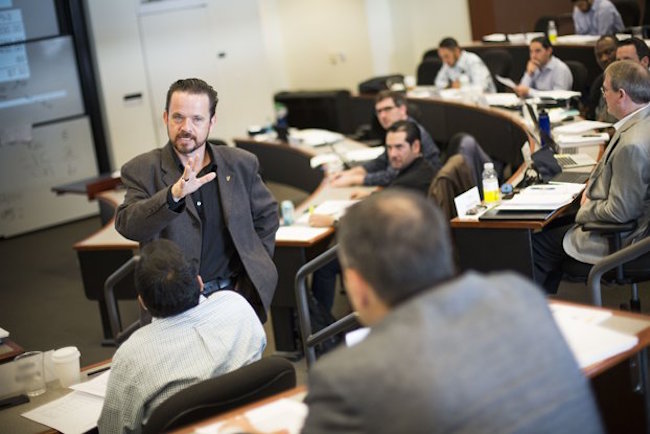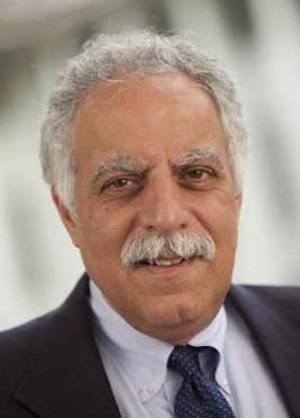
An Executive MBA class at Emory University’s Goizueta School of Business
It’s no secret that the Executive MBA market has seen some dramatic change in recent years. Company sponsorship has dried up. The road warrior status of many students means that they need even greater flexibility than ever before. More EMBA students view the degree as a means toward a significant career change, and this trend increasingly suggests that the traditional general management curriculum of an EMBA program isn’t providing the best platform for going into a new discipline, company or industry.
The latest school to grapple with these new realities is Emory University’s Goizueta School of Business. After gathering the views of students and alumni over three years, listening to numerous focus groups, and putting together a competitive benchmarking study, the team leading the school’s EMBA program has led a significant overhaul of the program and its approach to the market.
The new program breaks the traditional alternating weekend model, provides the option to concentrate in a specific discipline, vastly expands the menu of available elective courses, adds more experiential work to the curriculum, and still maintains the same rigor of the school’s full-time MBA program, requiring 51-credit hours and 32 contact hours for each of the 17 courses in the EMBA program.
‘THE MODEL HAD BECOME AN ENDURANCE MARCH MORE THAN AN EDUCATION’

Robert Kazanjian, vice dean of programs at Goizueta
The macro trends, of course, have been evolving for at least a dozen years. “There have been some pretty dramatic shifts over time in the executive MBA space,” acknowledges Robert Kazanjian, vice dean of programs at Goizueta. “We have been in this game since the mid-1970s and was one of the first when students were typically sponsored and released from their companies. It was the Golden Age. We had a four-semester, 18-month model where students took four courses a term in a lockstep program. Today, there is much less support from companies. Students are pretty much doing this on their own, facing pressures from leaving work to do it. And many of them want to shift to different industries and companies.”
While the school’s research helped to inform the changes, it was what professors were seeing in the classroom that partly led to the reboot of the program. “I found students to be more and more diverted from the classroom to workplace pressures,” adds Kazanjian, who teaches courses in strategy and change management. “A number of us worried that the model had become an endurance march more than an education. By the second or third term, stuff was just bouncing off the students.”
To address increased pressure from work, the school made an unusual decision. After the first 12 months, Goizueta is breaking the alternating Friday-Saturday format and shifting to a Saturday-Sunday morning model. Why? “What we found from the research is that students can get a buy-in for about 12 months from the family and their employer,” explains Doug Bowman, a professor of marketing and senior associate dean for working professional MBA programs at Goizueta. “After that, the employer starts asking, ‘Remind me again when you are done?’ We knew we had to do something there.”
REDUCED FRIDAY SESSIONS TO 23 FROM 40 TO RELIEVE WORK PRESSURES
Instead of having to takeoff from work a total of 40 Fridays, the new design requires 23 Friday sessions. The Sunday electives will start at 9 a.m. and to until 1 p.m., allowing students to return home to their famlies for the afternoon. After all, like most other EMBA programs, Goizueta attracts students with demanding jobs and hectic family lives. The average age of an EMBA stduent at Goizueta is 36, with some 13 years of work experience. Roughly 37% of the Class of 2016 is composed of women. And most hold jobs in operations, business development, marketing, project management and finance.
No less crucial in the redesign, though, is the ability to concentrate in a specific area. “One word jumped out from all our research and it was flexibility,” says Bowman. Students wanted much more flexibility in the curriculum. We were largely a lockstep program up until then. The data showed that 55% of our weekend students self-select on the way in wanting to switch industries or functions. From a curriculum perspective, students are looking for credentials to make those transitions. They want access to courses, topics and tools that full-time MBAs have. We knew we needed to adjust the curriculum to provide the opportunity for customization.”
The upshot: EMBA students at Goizueta who used to get few elective options out of 16 courses will now have a minimum of seven electives, with eight business foundation courses and three immersions. They can choose among concentrations in finance, strategy, healthcare, leadership, and general management. All told, the school now offers 21 electives for EMBA students and the chance to take another 25 to 30 in the evening with other students.





Questions about this article? Email us or leave a comment below.